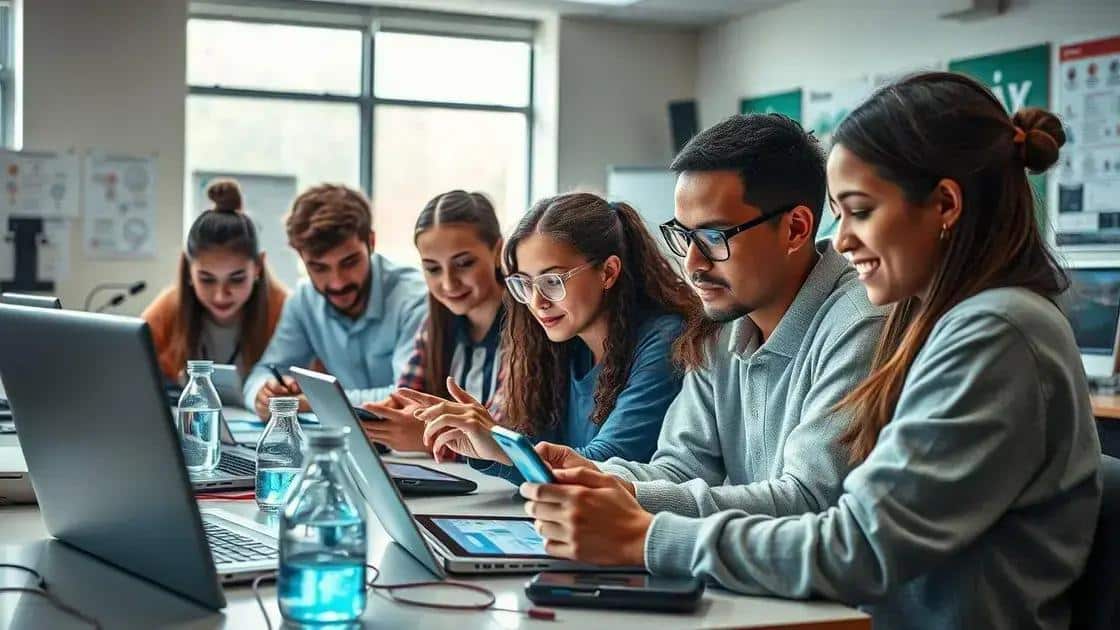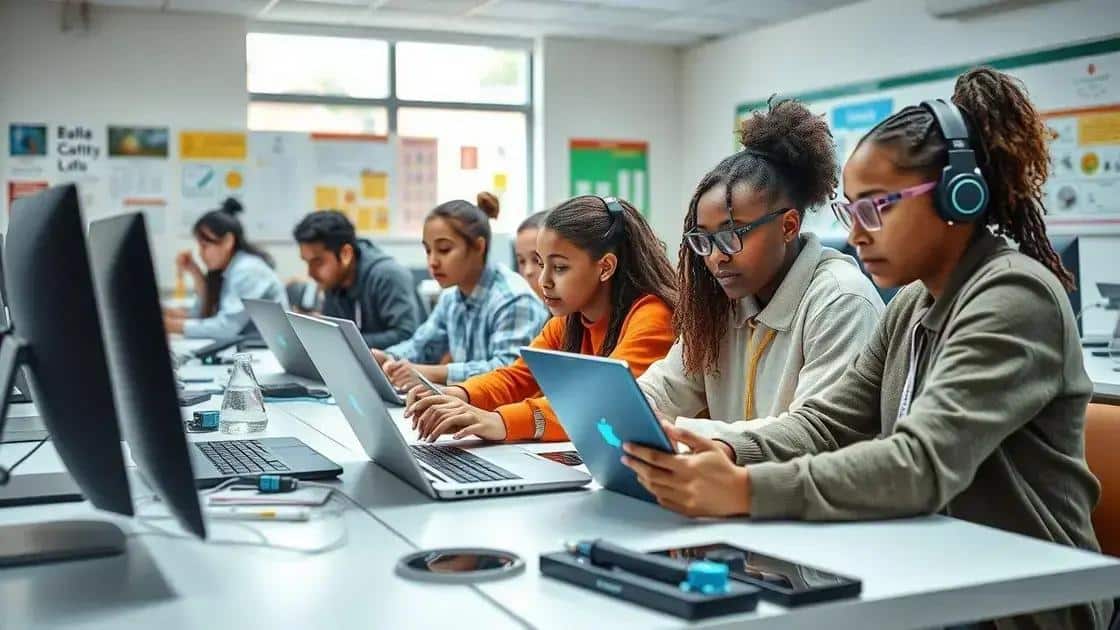Insights on virtual lab simulations: a game changer

Virtual lab simulations enhance education by providing accessible, interactive experiences for students to conduct experiments and learn scientific concepts safely and effectively.
Insights on virtual lab simulations reveal a fascinating way to learn without the constraints of a physical lab. Have you ever wondered how these simulations can transform education and make complex concepts more accessible?
Understanding virtual lab simulations
Understanding virtual lab simulations is essential for grasping how technology is changing education. These simulations allow students to explore complex concepts without the limitations of physical materials.
In this digital age, many educators are turning to virtual labs to enhance their teaching methods. They provide a safe environment for experimentation, where mistakes can lead to learning opportunities without the risk of accidents.
The core features of virtual lab simulations
Many features make virtual lab simulations effective:
- Interactive interfaces that engage students.
- Real-time feedback that enhances understanding.
- Access to a variety of tools and materials that would be unavailable in traditional settings.
These elements combine to create a rich learning experience. Students can manipulate variables and observe outcomes instantly, helping them to grasp complex scientific principles.
Benefits of virtual labs for students
Like real labs, virtual labs also allow students to conduct experiments efficiently, but with added benefits:
- Convenience of working from anywhere.
- Flexibility in pacing, allowing students to learn at their own speed.
- Cost-effectiveness, reducing the need for expensive materials.
This flexibility enhances the learning experience, making science accessible to a broader audience. In addition, educators can track student progress through the simulation, making adjustments as needed to maximize learning.
Ultimately, understanding virtual lab simulations reveals their potential to redefine how students interact with science and technology. As these tools continue to evolve, they will play a crucial role in shaping the future of education.
Benefits of using virtual labs in education

The benefits of using virtual labs in education are transforming how students learn science and technology. These innovative tools provide an interactive way to engage with difficult concepts, making learning both fun and effective.
One significant advantage is accessibility. Students can access virtual labs from anywhere, allowing them to experiment outside the traditional classroom. This flexibility is especially important for those who may have limited opportunities for hands-on experiences.
Key advantages of virtual labs
There are several key benefits that virtual labs offer to educators and students:
- Enhanced engagement: Virtual simulations captivate students’ attention, leading to higher motivation.
- Safe experimentation: Students can make mistakes without the risks associated with physical labs.
- Cost-efficient: Virtual labs reduce the need for costly materials and facilities.
These features allow students to explore scientific questions in a controlled environment. They can conduct experiments at their own pace and revisit them as many times as needed, which reinforces learning.
Improved learning outcomes
Research shows that students using virtual labs often achieve better learning outcomes. The chances for immediate feedback and adaptive learning help tailor the education experience. Educators can monitor student progress easily, giving them insight into areas that need more focus.
Furthermore, integrating virtual labs into the curriculum can support diverse learning styles. Whether a student is visual, auditory, or kinesthetic, these labs create a unique opportunity for everyone to thrive in their learning environment.
By embracing the benefits of virtual labs, educators can prepare students for a technology-driven world. As schools continue to seek effective teaching methods, virtual labs will undoubtedly play a vital role in shaping the future of education.
How to effectively implement virtual lab technologies
Implementing virtual lab technologies effectively requires careful planning and strategy. Schools and educators can harness these tools to enhance the learning experience for students.
First, it’s essential to assess the needs of the students and the curriculum. By understanding the specific requirements, educators can choose virtual lab platforms that align with educational goals. This groundwork ensures students will benefit from the technology in their learning process.
Steps to implement virtual labs
Here are key steps for successful implementation:
- Choose the right platform: Select virtual lab software that complements your educational objectives.
- Provide training: Offer training sessions for both teachers and students to familiarize them with the technology.
- Integrate with existing curriculum: Ensure the virtual labs are incorporated into the learning schedule and linked to lessons.
These steps facilitate the adoption of virtual lab technologies in a practical way. Continuous support and resources can further assist instructors and students in using these tools effectively.
Monitoring and feedback
Monitoring student progress is a crucial aspect of using virtual labs. Educators should track how students engage with the simulations and their overall understanding of the material. Feedback is vital; students should have the opportunity to provide input on their experiences with the virtual labs. This input can help improve the implementation strategy.
Moreover, integrating assessments through the virtual labs allows for real-time evaluation of student capabilities. This immediate feedback loop can help identify areas that may require extra attention, enhancing the learning environment.
By combining thoughtful implementation, ongoing support, and continuous evaluation, educators can maximize the benefits of virtual lab technologies, making science and technology more accessible for all students.
Challenges and solutions in virtual lab simulations

Challenges and solutions in virtual lab simulations are important topics to explore as these technologies evolve. While they offer numerous benefits, there are still hurdles educators and institutions must overcome to maximize their effectiveness.
One challenge is the accessibility of technology. Not all students have the necessary devices or reliable internet connections to engage with virtual labs fully. To address this, schools can provide equipment or create partnerships with local organizations to ensure all students have the resources they need.
Common challenges in implementing virtual labs
When considering the use of virtual lab simulations, several challenges may arise:
- Teacher training: Educators must feel confident using new technology. Lack of training can lead to missed opportunities in the classroom.
- Technical issues: Glitches or software problems can disrupt learning experiences. Schools need reliable tech support to resolve these quickly.
- Curriculum integration: Aligning virtual labs with existing curricular objectives can be complex. Educators need clear guidelines to ensure they’re used effectively.
Addressing these challenges proactively helps create a more positive experience for both students and teachers. Continuous professional development can equip educators with the necessary skills to effectively use virtual labs.
Solutions to enhance the virtual lab experience
To tackle these challenges, various solutions can be implemented. For instance, creating a robust support network can greatly improve the implementation process. This network can include IT professionals, educational leaders, and experienced educators who can share best practices.
Additionally, encouraging student feedback is essential. This feedback can help educators identify areas for improvement and customize the use of virtual labs to better meet their students’ needs.
Ultimately, overcoming the challenges and finding solutions in virtual lab simulations can lead to a richer educational experience, preparing students for the future of STEM learning.
virtual lab simulations hold great promise for the future of education. They offer unique benefits like accessibility, enhanced engagement, and safe experimentation. By tackling challenges and implementing effective strategies, educators can create a more dynamic and inclusive learning environment. Embracing these technological advances will prepare students for a world increasingly reliant on science and technology, ensuring they receive a relevant and updated education.
FAQ – Frequently Asked Questions about Virtual Lab Simulations
What are virtual lab simulations?
Virtual lab simulations are online platforms that allow students to conduct experiments and learn scientific concepts in a digital environment.
How do virtual labs enhance learning?
They provide interactive experiences, allow safe experimentation, and make complex topics more accessible to students.
What challenges might educators face when implementing virtual labs?
Common challenges include ensuring access to technology, providing adequate training for teachers, and integrating labs into the curriculum.
How can feedback improve the use of virtual labs?
Gathering feedback from students helps educators understand their experiences and make necessary adjustments for better engagement and learning outcomes.






